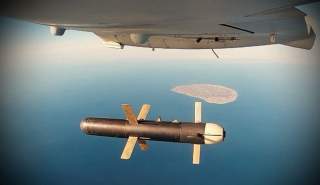Can't Touch This: Why Missiles and Drones Are Getting Harder to Stop
Iran's attack on Saudi Arabia is a case in point.
Key point: Even the best defenses can't always detect and stop a drone or missile swarm.
The Abqaiq attacks this month raised many questions. Who did it? How did they do it? What did they do it with? One question was notably absent: Why couldn't Saudi Arabia stop it? The answer is not straightforward, nor is it necessarily clear that anything could have stopped it. After all, the Kingdom spends as much as any country on defense.
The uncomfortable reality is that no one knows how to deal with this threat. It is not just the Saudis. American military bases in the Middle East were likely equally exposed. Inexpensive, asymmetric, ubiquitous threats traveling at high speeds is a hard problem. They resemble something similar to an emergent property, in which simple entities (drones and cruise missiles, for example) operate in an ecosystem, forming more complex behaviors as a collective. Stopping one drone may have not been a challenge. Stopping 17 drones and eight cruise missiles launched together confusing radars, communications infrastructure, and human operators all at once are. Whether we like it or not, when it comes to this new era of defense, humans can be just as much the problem as they are the solution.
Five years ago, the Department of Defense started seriously contemplating how two major developments - a raft of new technologies, like artificial intelligence (AI), machine learning and autonomy, and increasingly commoditized (and therefore cheaper) sensors and hardware - posed serious risks to its existing legacy defense systems. The Pentagon released a report calling for the transformation of the defense industry, concerned that its legacy systems were no match for a rapidly approaching new era. But mainstreaming new tech into the "SOPs and TTCs" of various branches of the military ran aground. Legacy companies, late to the game and unable to attract the talent necessary to compete in the new industries, piled on and pushed for incremental change to existing technologies to defend their core business interests. A core argument of the anti-changers: humans were needed "in the loop." HITL, as "humans in the loop" became known, conveniently reflected the operating systems of their own products.
The problem was – and remains – that any system reliant on a human operator paired with bespoke, non-interoperable controls is at risk. The adversary is always looking for where humans are managing assets, because they know there are likely fault lines nearby. In this context, humans – their faults and frailties – are accentuated. We cannot think, act, reason quickly enough for a world in which dozens of cheap, smart objects fly at hypersonic speeds at multiple targets.
The question isn't, "Do we want humans in the loop?" Of-course we do. The question is where. New defense technologies, especially those that offer defensive measures against fast moving swarms of flying vessels, need to minimize human's decision load such that they are no longer identifying and classifying targets but can instead offload those tasks to computational mechanisms that are capable of processing that faster and more accurately. Humans then only have the burden of deciding how to engage, with computer assistance telling them the most useful countermeasure. The reality is that in most air defense systems, humans are everywhere in the loop. They are in front of screens, behind radars, tipping, queuing, identifying, classifying, coordinating.
The solution to this threat is not radars that see further, or bigger and faster interceptor missiles or even more HITL. The solution is structural: inexpensive, infinitely scalable sensor systems that fuse data feeds offering as an accurate, non-hackable picture of reality as possible. Daisy-chained radars interlinked by a mesh network track the paths of each enemy drone autonomously handing off to the next. Humans maintain control of the intent; not the process.
These advances in technology and their gradual commoditization do not represent linear, incremental changes to global security. They represent a paradigm shift in thinking about defense and warfare. As the Saudi attacks so clearly demonstrate, their combination makes defense exponentially more challenging to human operators. Before the next attack, we need to realize that being everywhere in the loop is the same as being out of it.
Eliot Pence is a Senior Associate at the Center for International and Strategic Studies and leads international expansion for Anduril Industries.
This article by Euan Graham originally appeared at Real Clear Defense. This article first appeared earlier in 2019.
Image: Reuters

